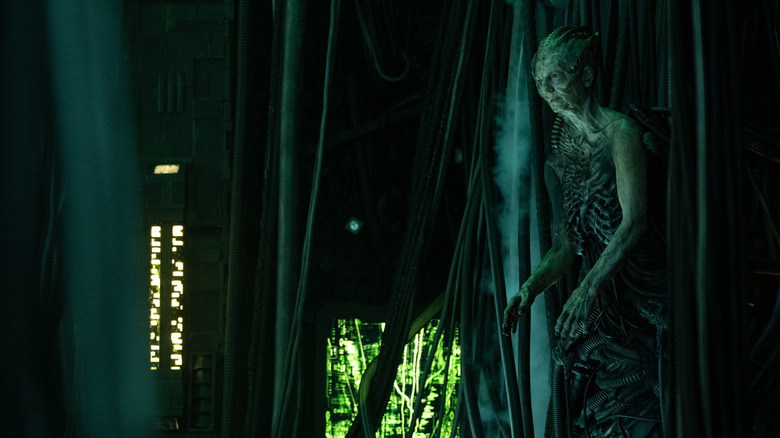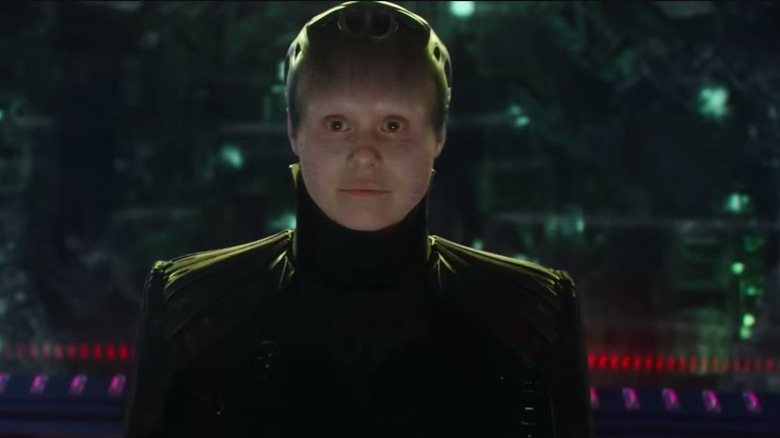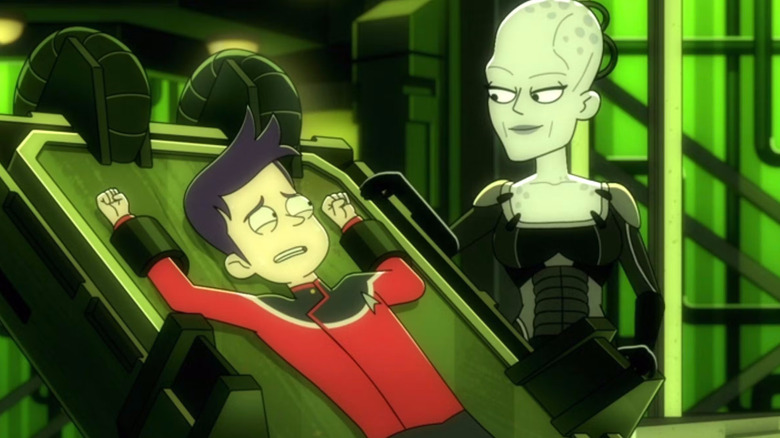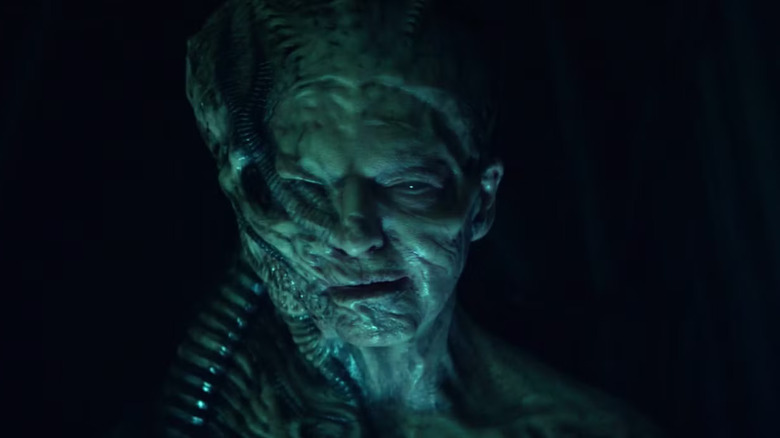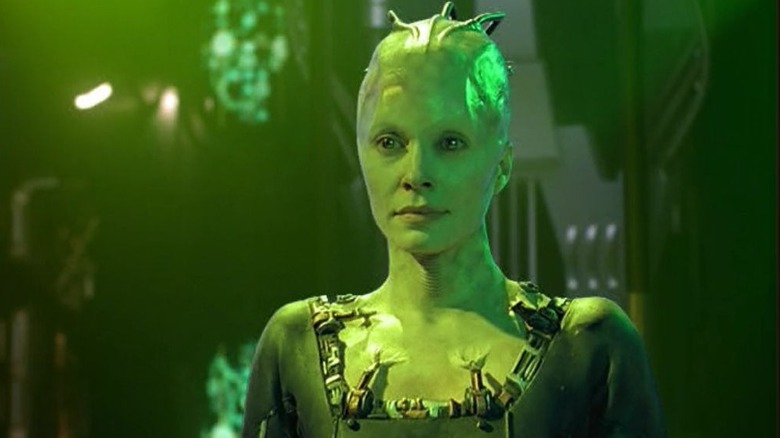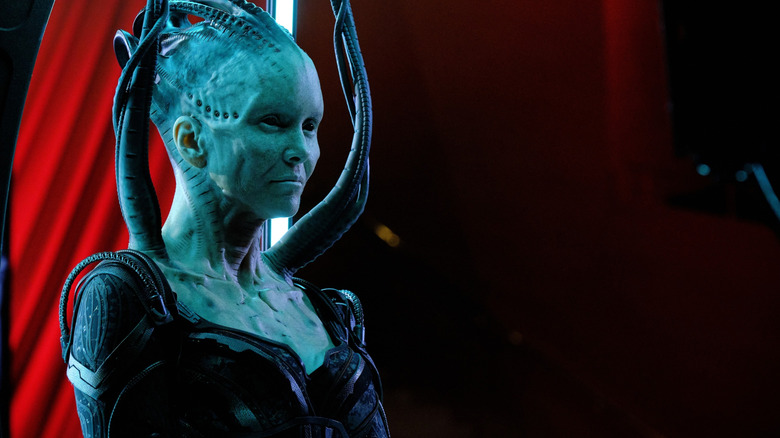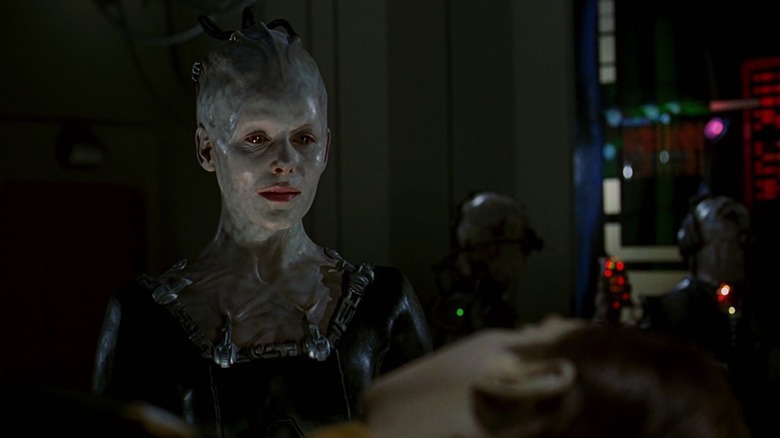Every Version Of The Borg Queen On Star Trek, Ranked
We may receive a commission on purchases made from links.
When the Borg were first introduced in the "Star Trek: The Next Generation" episode "Q Who" (May 8, 1989), they were ineffable, mysterious, and terrifying. They were a race of cyborgs that were bound by a single machine consciousness, existing only to grow and expand. They did this by stealing resources from others. When the Borg encountered a starship, they would scan it, find technology they didn't have, carve it up, and absorb its pieces into their own cube-shaped craft. To shore up their numbers, they would kidnap humanoid species as "assimilate" them. That is: implant their bodies with tubes and computers and force them to serve as mindless robot drones.
The Borg returned throughout "Next Generation," and each time were described as having a collective consciousness. It wouldn't be until "Star Trek: First Contact" in 1996 that the Borg would be likened to a beehive. There was now a structured hierarchy within the Borg, making them more traditionally biological. And if the Borg were a hive, then they certainly have a Queen, right?
Alice Krige played the Borg Queen in "First Contact," and she, unlike other Borgs, did have a voice and a personality. She could be reasoned with, and explained that the Borg believed in a philosophy of perfection, achieved through the synthesis of man and machine. With the introduction of the Queen, the Borg became calculating, sweaty, sexual, and sinister. More traditionally villainous. The Borg Queen was killed at the end of that film, but the character was too delicious to leave behind entirely.
Indeed, various Trek writers have implied that the Borg Queen is interdimensionally capable, leaving her to return in various forms. Multiple actresses have played the Borg Queen in the ensuing years, and it can be argued if they're supposed to be the same character as the one seen in "First Contact."
The various Borg Queen forms number seven, and they will be ranked below.
7. Alison Pill (from 'Star Trek: Picard,' season 2)
In the second season of "Star Trek: Picard" (March 3 to May 5, 2022), Picard (Patrick Stewart) was hurled into an "evil" alternate dimension by the trickster deity Q (John de Lancie). There, he found that Earth was under a vicious, genocidal dictatorship devoted to murdering all other species in the galaxy. He arrived on the eve of the execution of the last known Borg, a Queen played by Annie Wersching. Picard rescued the Queen, and fled by traveling back in time. He and several compatriots, including Dr. Agnes Jurati (Alison Pill), arrived in the year 2024 with the Borg Queen in their custody.
Over the course of the season, the Queen and Dr. Jurati would match wits, leading to the pair physically bonding via a brain link. This allowed the Queen to infect Dr. Jurati's brain and, very slowly, take over her body. By the end of the season, Dr. Jurati has become the new Borg Queen, and will be seen eating car parts to get some metallic cyborg elements back inside of herself.
She's not a very interesting Borg Queen. The conceit is that Jurati and the Queen are somehow psychically influencing one another, leading to a kinder, gentler Borg. In one of the season's final scenes, after Picard and Co. have returned to their own timeline, Jurati reveals that she has been living as a Borg Queen for centuries, and that the Borg are now ready to be cooperative and nondestructive.
The Borg, of course, have assimilated untold trillions of people in their history, so it's unclear why Dr. Jurati's human mind in particular would be able to change the Borg so dramatically. Making the Borg into gentle "good guys" kind of reduces their terrifying power.
6 and 5. (tie) Alice Krige (from 'Star Trek: Voyager') and Alice Krige (from 'Star Trek: Lower Decks')
The Borg played a large role in the 1995 series "Star Trek: Voyager," and that series involved several Borg Queens. As mentioned, one can make an argument that all the Borg Queens are mere interdimensional variants of one another, although one could also argue that Queens are killed and replaced frequently. As such, when Alice Krige appeared as the Borg Queen in the final episode of "Voyager," called "Endgame" (May 23, 2001), Trekkies had to begin arguing whether or not it was the same version we met in 1996. Krige's identity made even more unclear, as another actress, Susanna Thompson, already played the character on "Voyager."
When the character returned for "Endgame," though, she wasn't given any new quirks or tics. She was the same mere supervillain Trekkies had previously seen. She ranks low for the lack of innovation.
Krige also returned to play a holographic version of the Borg Queen in "Star Trek: Lower Decks" episode "I, Excretus" (September 30, 2021). In that episode, Ensign Boimler (Jack Quaid) entered a personal holodeck to see if he could escape a simulated Borg scenario. Boimler was able to escape with his wit, but the holodeck's scoring system gave him a bad grade. Boimler replayed the scenario multiple times, hoping he could get a 100% score. The simulated Borg Queen, in this case, was treated as little more than a background gag.
4. Alice Krige and Jane Edwina Seymour (from 'Star Trek: Picard,' season 3)
In the final two episodes of "Star Trek: Picard" — "Võx" (April 13, 2023) and "The Last Generation" (April 20, 2023) — is was revealed that the Dr. Jurati Borg Queen was but an aberration, and that there was still a small sect of dying Borgs in the galaxy that were still interested in assimilation. The final few Borgs have all moved onto one massive warship, and have been using a clever transporter trick to "implant" a Borg gene (?) into the brains of Starfleet personnel. Once the gene is activated, all the infected people will instantly fall under the Borg mandate. The process will be overseen by a beleaguered Borg Queen played bodily by Jane Edwina Seymour, but voiced by Krige.
The original design of the Borg was clearly inspired by the artwork of Swiss surrealist H.R. Giger (the "Alien" guy), and the design for the dying Borg Queen in "Picard" cleaves closer than ever to its inspiration. The Queen is barely alive, now constructed more of tubes than of organic material. She also reveals that she wants to enact revenge just as much as she wants to fulfill the Borg assimilation ethos.
In terms of story, this Borg Queen is merely a villain that is bested by an explosion. She's not terribly interesting as a character. She is, however, the scariest Borg Trekkies have seen in a while. She's slick with sweat and mechanical condensation, pathetic and rotten, like a sci-fi haunted house monster. She ranks high because, well, she's cool.
3. Susanna Thompson (from 'Star Trek: Voyager')
Certain whiny Trekkies — whiny Trekkies like me — have complained in our more dissatisfied moments that the introduction of the Borg Queen made the whole species less interesting. If the Borg had clearly stated motivations, it implies that they can enter a state of negotiation. And if they can negotiate, they can change their minds. And if they can change their minds, well then they're not the ultimate users they once were. The Borg, purists would argue, should remain mute killers like Michael Myers.
It was Susanna Thompson who brought back a machine-like efficiency to the character. Thompson played the Borg Queen in three episodes of "Voyager," including in the two-hour TV movie "Dark Frontier." She is the one who introduces the notion that the Borg believe so deeply in mechanical perfection that they, once again, cannot be convinced of anything else. Thompson's performance turned the Borg from villains back into unstoppable monsters. Of course, she would be stopped, but she made the Borg into more interesting villains again, merely through her physical tics and scary, calculated line readings. She made the Borg philosophy feel seductive and attractive.
Also, she was a great contrast to Seven of Nine (Jeri Ryan), a character that made the Borg seem like they could be redeemed. Thompson proved that it was just a matter of philosophy.
2. Annie Wersching (from 'Star Trek: Picard,' season 2)
The late Annie Wersching played a Borg Queen culled from a parallel universe. Her villainy was, in this iteration, more intense. Indeed, even when she was a mere head, arms, and torso, held aloft inside an execution machine, one could see her mental wheels turning, her confidence never wavering. Unlike the rotting Borg Queen from the third season of "Picard," this one wasn't pathetic or desperate or motivated by revenge. This Borg was planning an escape, even if she had to do so up to the last microsecond. This Borg Queen had a scheme.
Indeed, even without mobility, she knew she could influence others. She was demonic, in a way, tempting people with sweet words and clever arguments. She's a far cry from the techno-zombies of the "Next Generation" days, but golly is she threatening.
This, I think, feels more natural to the development of the Borg than last-ditch mass assimilation efforts as seen in the third season. The Borg can afford to think in the long term, and assimilating one person is a fine start for them. Even if it takes centuries, the Borg will return. Wersching's amazing performance communicated that she's evil enough to wait it out. It's kind of unfortunate that her fusion with Dr. Jurati created a Borg Queen that was benevolent.
This Borg Queen is a B-movie villain, but she's an effective one.
1. Alice Krige (from 'Star Trek: First Contact')
The original may be the best, as she remains the most mysterious. "First Contact" introduced the Borg Queen for the first time, and she emerges less like a Borg and more like a Cenobite from "Hellraiser." Her skin is stretched tight into a "bun" on the back of her head, and her skin is sickly and newt-like. Her body is mostly robotic, her fleshy shoulders clamped inside with painful-looking hooks. And in this state, she thinks to seduce Data (Brent Spiner). It works.
This Queen claims to be a manifestation of the Borg's group mind, speaking for them all (on "Voyager," in contrast, she would serve more as a leader, giving orders to underlings). Data asks her how the Borg command structure works, now that they seem to have a leader, and her cryptic response is that she brings order to chaos.
In the oral history book "The Fifty-Year Mission: The Next 25 Years: From The Next Generation to J. J. Abrams," edited by Mark A. Altman and Edward Gross, the writers of "First Contact" admitted that they wanted to make a movie about the Borg, but that they were at a loss as to what kind of story they wanted to tell; the Borg, after all, are zombie-like in their function, and little was left to be explored. They admitted that creating the Borg Queen was the only way they could expand the Borg in ways they found satisfying. The Queen does make the Borg less threatening, but Krige, at the very least, also introduced new mysteries.
"You humans think in such three-dimensional terms," she says at one point. Does the Borg consciousness span the multiverse? If so, how? The new questions were, at the very least, intriguing.
